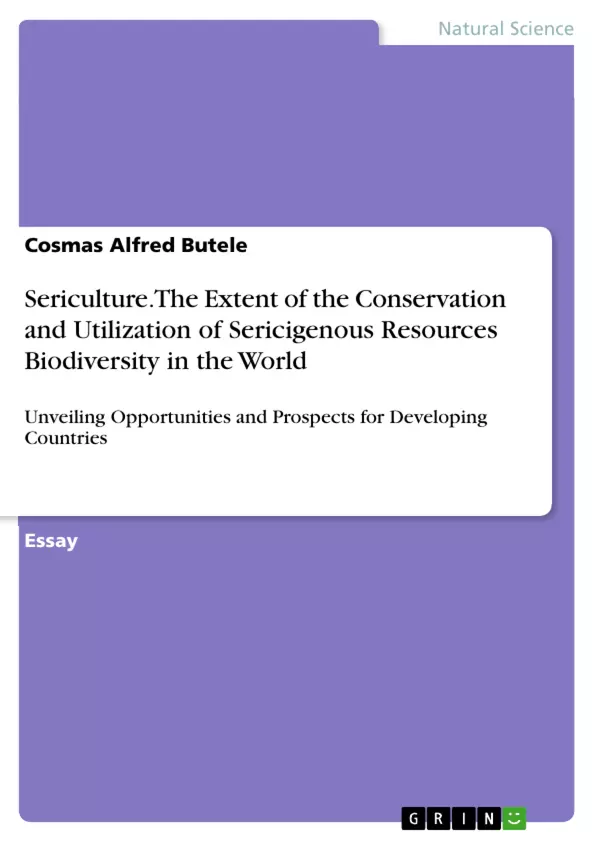Sericigenous fauna are animals that are capable of producing a natural and highly valued fibre called silk. According to Prasadet al.(2010), the word “Sericigenous” is derived from a Greek word “Seri” meaning Silk. Sericigenous fauna have a wide biodiversity, which can be primarily categorized as insect and non-insect groups. The non-insect group includes the Adriatic mussel (seashell Pinna nobilis and related species which produce silk referred to as sea silk) and a Madagascarian spider. The silk of non insect origin is of no importance to textile market as its use is limited in the area of optical instruments. The insect group includes all the silk spinning insects whether foraging on mulberry plant or other non mulberry plants; their silk is the one used in making garments. Therefore, Sericigenous resources include the silk producing animals and the associated plants they feed on. This paper reviews the sericigenous resources biodiversity that have so far been identified and documented and the efforts that have been put in place to conserve and utilize them sustainably. The emphasis here is laid on the Sericigenous insects, the silk moths, and their food plants.
Inhaltsverzeichnis (Table of Contents)
- Introduction
- Importance of Sericigenous Resources and Conservation
- Description of the Extent of Sericigenous Resources Biodiversity Conservation and Utilization in the world
- General Analysis of the Extent of Sericigenous Resources Biodiversity Conservation and Utilization in the world
- Actualization: Practical case studies of Bombyx mori Conservation and Utilization in China, India and Uganda
- Actualization: Practical Case Studies of Wild Silkworm Conservation and Utilization in the world
- Discussions: Advantages and Disadvantages of Sericigenous Resources Biodiversity Conservation and Utilization
- General Recommendations
- Conclusion
Zielsetzung und Themenschwerpunkte (Objectives and Key Themes)
This work explores the conservation and utilization of sericigenous resources biodiversity, focusing particularly on the opportunities and prospects for developing countries. The paper examines the importance of these resources and provides an overview of their conservation and utilization globally. Additionally, it delves into specific case studies of silkworm conservation and utilization in various regions, highlighting practical applications.- The significance of sericigenous resources for economic development and biodiversity conservation
- The extent of biodiversity conservation and utilization practices in the world
- Case studies of Bombyx mori and wild silkworm conservation and utilization in various countries
- Advantages and disadvantages of sericigenous resources biodiversity conservation and utilization
- Recommendations for promoting sustainable practices and maximizing the potential of sericigenous resources
Zusammenfassung der Kapitel (Chapter Summaries)
- The introduction sets the stage for the paper, outlining the focus on sericigenous resources, their importance, and the goal of exploring opportunities for developing countries.
- Chapter 2 emphasizes the significant role of sericigenous resources, including silkworms and their food plants, in economic development and biodiversity conservation.
- Chapter 3 delves into the current state of sericigenous resources biodiversity conservation and utilization worldwide, providing a comprehensive overview of practices and challenges.
- Chapter 4 offers a detailed analysis of the conservation and utilization of sericigenous resources globally, exploring trends and potential for further development.
- Chapter 5 presents practical case studies of Bombyx mori conservation and utilization in China, India, and Uganda, highlighting successful strategies and challenges faced in each region.
- Chapter 6 examines practical case studies of wild silkworm conservation and utilization worldwide, showcasing diverse approaches and their impact on local communities and economies.
- Chapter 7 discusses the advantages and disadvantages of sericigenous resources biodiversity conservation and utilization, exploring both the potential benefits and challenges associated with these practices.
- Chapter 8 provides general recommendations for promoting sustainable practices and maximizing the potential of sericigenous resources for developing countries.
Schlüsselwörter (Keywords)
This work focuses on sericigenous resources, biodiversity conservation, silkworm, Bombyx mori, wild silkworms, economic development, sustainable practices, developing countries, and case studies. The research highlights the importance of promoting responsible utilization of these resources to benefit both the environment and communities.- Quote paper
- BSc, MS (Candidate) Cosmas Alfred Butele (Author), 2012, Sericulture. The Extent of the Conservation and Utilization of Sericigenous Resources Biodiversity in the World, Munich, GRIN Verlag, https://www.hausarbeiten.de/document/207282


